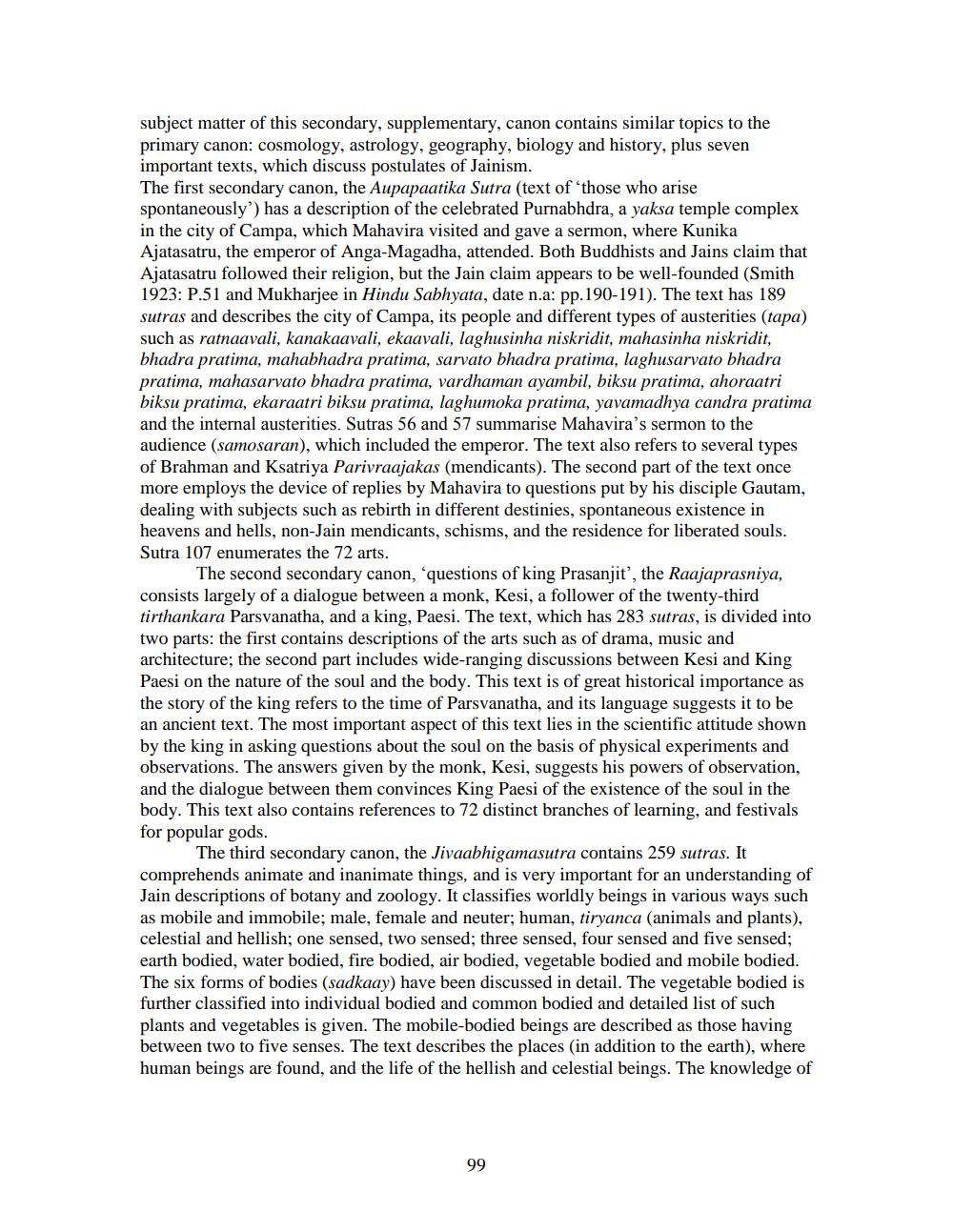________________
subject matter of this secondary, supplementary, canon contains similar topics to the primary canon: cosmology, astrology, geography, biology and history, plus seven important texts, which discuss postulates of Jainism. The first secondary canon, the Aupapaatika Sutra (text of those who arise spontaneously' has a description of the celebrated Purnabhdra, a yaksa temple complex in the city of Campa, which Mahavira visited and gave a sermon, where Kunika Ajatasatru, the emperor of Anga-Magadha, attended. Both Buddhists and Jains claim that Ajatasatru followed their religion, but the Jain claim appears to be well-founded (Smith 1923: P.51 and Mukharjee in Hindu Sabhyata, date n.a: pp. 190-191). The text has 189 sutras and describes the city of Campa, its people and different types of austerities (tapa) such as ratnaavali, kanakaavali, ekaavali, laghusinha niskridit, mahasinha niskridit, bhadra pratima, mahabhadra pratima, sarvato bhadra pratima, laghusarvato bhadra pratima, mahasarvato bhadra pratima, vardhaman ayambil, biksu pratima, ahoraatri biksu pratima, ekaraatri biksu pratima, laghumoka pratima, yavamadhya candra pratima and the internal austerities. Sutras 56 and 57 summarise Mahavira's sermon to the audience (samosaran), which included the emperor. The text also refers to several types of Brahman and Ksatriya Parivraajakas (mendicants). The second part of the text once more employs the device of replies by Mahavira to questions put by his disciple Gautam, dealing with subjects such as rebirth in different destinies, spontaneous existence in heavens and hells, non-Jain mendicants, schisms, and the residence for liberated souls. Sutra 107 enumerates the 72 arts.
The second secondary canon, 'questions of king Prasanjit', the Raajaprasniya, consists largely of a dialogue between a monk, Kesi, a follower of the twenty-third tirthankara Parsvanatha, and a king, Paesi. The text, which has 283 sutras, is divided into two parts: the first contains descriptions of the arts such as of drama, music and architecture; the second part includes wide-ranging discussions between Kesi and King Paesi on the nature of the soul and the body. This text is of great historical importance as the story of the king refers to the time of Parsvanatha, and its language suggests it to be an ancient text. The most important aspect of this text lies in the scientific attitude shown by the king in asking questions about the soul on the basis of physical experiments and observations. The answers given by the monk, Kesi, suggests his powers of observation, and the dialogue between them convinces King Paesi of the existence of the soul in the body. This text also contains references to 72 distinct branches of learning, and festivals for popular gods.
The third secondary canon, the Jivaabhigamasutra contains 259 sutras. It comprehends animate and inanimate things, and is very important for an understanding of Jain descriptions of botany and zoology. It classifies worldly beings in various ways such as mobile and immobile; male, female and neuter; human, tiryanca (animals and plants), celestial and hellish; one sensed, two sensed; three sensed, four sensed and five sensed; earth bodied, water bodied, fire bodied, air bodied, vegetable bodied and mobile bodied. The six forms of bodies (sadkaay) have been discussed in detail. The vegetable bodied is further classified into individual bodied and common bodied and detailed list of such plants and vegetables is given. The mobile-bodied beings are described as those having between two to five senses. The text describes the places in addition to the earth), where human beings are found, and the life of the hellish and celestial beings. The knowledge of




